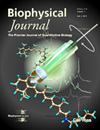Role of ionic electrodiffusion and ephaptic coupling in cardiac dynamics.
IF 3.1
3区 生物学
Q2 BIOPHYSICS
引用次数: 0
Abstract
Cardiac myocytes coordinate the heart contractions through electrical signaling, facilitated by gap junctions (GJs) in the intercalated disc (ID). GJs provide low-resistance pathways for electrical propagation between myocytes, acting as the main mechanism for electrical communication in the heart. However, studies show that conduction can persist in the absence of GJs. For instance, GJ knockout mice still display slow and discontinuous electrical propagation, suggesting the presence of alternative communication mechanisms. Ephaptic coupling (EpC) serves as an alternative way for cell communication, relying on electrical fields within narrow clefts between neighboring myocytes. Studies show that EpC can enhance conduction velocity (CV) and reduce conduction block (CB), especially when GJs are compromised. Reduced GJs and significant electrochemical gradients are prevalent in various heart diseases. However, existing models often fail to capture their combined influence on cardiac conduction, which limits our understanding of both the physiological and pathological aspects of the heart. Our study aims to address this gap through the development of a two-dimensional (2D) discrete multidomain electrodiffusion model that includes EpC. In particular, we investigated the interplay between EpC and multidomain electrodiffusion on action potential (AP) propagation, morphology, and electrochemical properties. Our findings indicate that under strong EpC, Na + electrodiffusion enhances CV, reduces the occurrence of CB, and sharpens the upstroke phase of the AP, while Ca 2+ and K + diffusion shorten the AP duration, alter the repolarization phase, and elevate the resting membrane potential. Additionally, when EpC is prominent, Na + electrodiffusion helps stabilize AP propagation and promotes its spread into ischemic regions. Strong EpC also significantly alters ionic concentrations in the cleft, markedly increasing [K +], nearly depleting [Ca 2+], and causing moderate changes in [Na +]. This multidomain electrodiffusion model provides valuable insights into the mechanisms of EpC in the heart.离子电扩散和心动偶联在心脏动力学中的作用。
心肌细胞通过电信号协调心脏收缩,这是由间插盘间隙连接(GJs)促进的。gj为肌细胞之间的电传播提供了低阻通路,是心脏电通信的主要机制。然而,研究表明,在没有GJs的情况下,传导可以持续存在。例如,GJ敲除小鼠仍然表现出缓慢和不连续的电传播,这表明存在其他通信机制。Ephaptic偶联(EpC)是细胞通信的另一种方式,依赖于相邻肌细胞之间狭窄间隙内的电场。研究表明,EpC可以提高传导速度(CV),减少传导阻滞(CB),特别是在GJs受损的情况下。降低gj和显著的电化学梯度在各种心脏疾病中普遍存在。然而,现有的模型往往不能捕捉到它们对心脏传导的综合影响,这限制了我们对心脏生理和病理方面的理解。我们的研究旨在通过开发包括EpC在内的二维(2D)离散多域电扩散模型来解决这一差距。我们特别研究了EpC和多畴电扩散对动作电位(AP)传播、形态和电化学性能的相互作用。结果表明,在强EpC作用下,Na +电扩散增强了CV,减少了CB的发生,使AP的上冲程变短;ca2 +和K +电扩散缩短了AP的持续时间,改变了复极化期,提高了静息膜电位。此外,当EpC突出时,Na +电扩散有助于稳定AP的传播并促进其向缺血区域扩散。强EpC还显著改变了裂缝中的离子浓度,使[K +]显著增加,[ca2 +]几乎耗尽,并引起[Na +]的适度变化。这种多域电扩散模型为研究EpC在心脏中的作用机制提供了有价值的见解。
本文章由计算机程序翻译,如有差异,请以英文原文为准。
求助全文
约1分钟内获得全文
求助全文
来源期刊

Biophysical journal
生物-生物物理
CiteScore
6.10
自引率
5.90%
发文量
3090
审稿时长
2 months
期刊介绍:
BJ publishes original articles, letters, and perspectives on important problems in modern biophysics. The papers should be written so as to be of interest to a broad community of biophysicists. BJ welcomes experimental studies that employ quantitative physical approaches for the study of biological systems, including or spanning scales from molecule to whole organism. Experimental studies of a purely descriptive or phenomenological nature, with no theoretical or mechanistic underpinning, are not appropriate for publication in BJ. Theoretical studies should offer new insights into the understanding ofexperimental results or suggest new experimentally testable hypotheses. Articles reporting significant methodological or technological advances, which have potential to open new areas of biophysical investigation, are also suitable for publication in BJ. Papers describing improvements in accuracy or speed of existing methods or extra detail within methods described previously are not suitable for BJ.
 求助内容:
求助内容: 应助结果提醒方式:
应助结果提醒方式:


